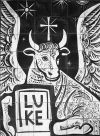
The Gospel of Luke
The Kingdom of God: Lk 13,10-21
The healing story is followed by the parables with simple connections in the text: "therefore" in verse 18 and "again" in verse 20. This tells us that we need to read the parables in light of the healing which preceeds them.
Furthermore, Luke has added the parable about a woman and leaven which is unique to him. It is common for Luke as we have seen to link together similar units about a man and a woman.
Luke has also has given the two parables a different setting. In Mark and Matthew, the parable of the mustard seed is part of a long discourse of parables (note the comments in Mark 4,33-34). Luke has instead used the parables of the mustard seed and the leaven as a commentary on the healing of the bent-over woman.
Back now to the main page to read this in more detail.
The Healing of the Bent-over Woman: Lk 13,10-18
Verse 10 tells us that Jesus was teaching in the synagogue on the sabbath, a setting which occurs several times in this Gospel - 4,16 and 6,6 for example. The healing in the latter case is the first healing where the healing is simply a trigger for the controversy, as we also see in 11,14 and 14,2. There is no request for a healing by Jesus as is common elsewhere. Here too, Jesus heals the bent-over woman without any request, but unlike the other instances, she at least gives a response to her healing.
We have seen a number of times already how this Gospel links illness and Satan - 11,14 just mentioned being another example.
We can note that the woman has been crippled for eighteen years and that is also the number of people killed by the tower of Siloam (13,4). More interesting is that twice the book of Judges record the people of Israel being oppressed for 18 years (Judges 3,14 and 10,8). There is therefore a suggestion that the woman involved in the healing stands for a wider oppression.
Jesus lays hands on her, his typical style of healing (4,40). The woman responds by standing up and praising God (verse 13).
Not all synagogue leaders were against Jesus, Jairus being a good example (8,41). As always, some leaders will be more open minded than others. This leader has a narrow view of the law: the sabbath is holy, healing is work.
Keeping the sabbath holy goes back to the ten commandments. The reasoning in Exodus (Ex 20,8-11) is simply that God rested on the seventh day of creation. Deuteronomy (Dt 5,12-15) goes further and tells the people to remember that they had been slaves in Egypt and that the Lord had brought them out with a mighty hand and outstretched arm. The sabbath becomes a weekly celebration of this freedom from oppression (Dt 5,15)
Jesus therefore begins in verse 15 by arguing from the lesser to the greater: the need to water animals points towards the need to fulfil human needs too.
The real point then follows in verse 16. The woman is called a daughter of Abraham, though a woman she is a full member of Israel (in the same way the tax collecter Zacchaeus is also a full member of Israel, 19,9). She has been bound by Satan for eighteen years just as the people of Israel were bound and oppressed by the Moabites and the Ammonites for eighteen years. The deeper meaning of the sabbath is drawn out by Jesus, the meaning given to it by the book of Deuteronomy. For Jesus, the sabbath is actually the best day of the week for the woman to be freed from her bondage.
Thus we have the contrast in verse 17: the leaders are confirmed in their hypocrisy (12,1) while the crowd is delighted - but crowds are fickle (12,56).
Let us return to the main page.
Two Parables: Lk 8,18-21
The kingdom of God is about freedom from oppression which has been a feature of the healing of the bent-over woman. The birds of the air would indicate a univeralism to the kingdom: all are welcome.
Leaven by contrast is hidden, the internal growth that is not visible, especially to those who do not want to see it, the hypocrites of this part of the Gospel.
For Luke therefore, the kingdom of God is growing, both as more people hear and accept the teachings of Jesus but there is also the hidden internal growth of the people as well.
Time to return to the main page.
The Quotation
This is just a general comment at the beginning of a good discussion of this passage. But this book on Women in the Gospel of Luke is bringing the feminist agenda to the Gospel. However such an agenda would have been very far from the evangelist's mind. Even so the Gospels generally and Luke in particular are remarkably open to the part women played in the life of Jesus. Whilst this quotation makes a notable point in a notable way, it is also reading rather more into the text than it can bear.
We can return now to the main page.
